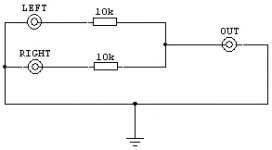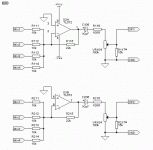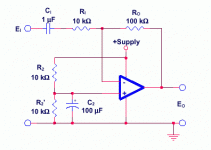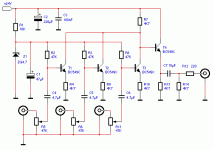JAZZ2250 said:I want to mix two audio signals into one and am wondering what will be the best way for this. Can I use a simple circuit like the following? Thanks.
It could work - I have used this way
to get a mono signal for testing my DIY-amplifiers.
Mostly we build one amp first.
-------------------------------------------
I made an own Adapter.
I soldered the resistors together with two phono-connectors
in one end of cable. And one phono in other end.
Then I put the adpter into the 2 output jacks,
and had a bit longer cable for to connect
the mono end to the amplifier input.
So it is a homemade cablage with stereo input and mono output.
----------------------------------
Sometimes it is better to use a buffer-mixer.
An OP-amp with gain=1, in inverted mode,
is what is usually used as a simple mixer.
I will go search for a Schematic on the web.
Maybe Elliot ESP, have something in OP-amp section
or in some of his Audio projects.
/halojoy
ESP project 94 - mixer
Here is Elliots mixer
Mixer - ESP project 94 Mixer
If you have 2 signals, use only 2 resistors at input.
you need only first part of the circuit -
only including output Cap - C106 (not the volume control at the out put)
You can use any OPamp - NE5532 OPA2134 or TL071 or UA741
(should be stable at gain=1)
But TL071 or TL072 is a good choice.
And they cost not much.
You can even supply with two 9V batteries - giving plus/minus 9 volt supply
Here is a figure from that link:
Here is Elliots mixer
Mixer - ESP project 94 Mixer
If you have 2 signals, use only 2 resistors at input.
you need only first part of the circuit -
only including output Cap - C106 (not the volume control at the out put)
You can use any OPamp - NE5532 OPA2134 or TL071 or UA741
(should be stable at gain=1)
But TL071 or TL072 is a good choice.
And they cost not much.
You can even supply with two 9V batteries - giving plus/minus 9 volt supply
Here is a figure from that link:
Attachments
How to use OP-amps
I tried to find a tutorial on OPamps
on the web.
didn't find any good website.
Maybe someone else can help.
I know there is good tutorials on www, somewhere.
------------------------------------------------
But if you want a REAL "bible" telling ALL about
op-amp use,
You can download this PDF 2 MB.
Handbook of Operational Amplifier Applications (Rev. A)
While in the process of reviewing Texas Instruments applications notes, including those from Burr-Brown – I uncovered a couple of treasures, this handbook on op amp applications and one on active RC networks. These old publications, from 1963 and 1966, respectively, are some of the finest works on op amp theory that I have ever seen. Nevertheless, they contain some material that is hopelessly outdated. This includes everything from the state of the art of amplifier technology, to the parts referenced in the document – even to the symbol used for the op amp itself.
It is from Texas Instruments - a maker of OP-amps.
Handbook of Operational Amplifier Applications
----------------------------------------
There is most things descibed in schematics
and dual or Single supplies.
/halojoy - just downloaded it himself
 Knowledge is not a HEAVY burdon
Knowledge is not a HEAVY burdon 
I tried to find a tutorial on OPamps
on the web.
didn't find any good website.
Maybe someone else can help.
I know there is good tutorials on www, somewhere.
------------------------------------------------
But if you want a REAL "bible" telling ALL about
op-amp use,
You can download this PDF 2 MB.
Handbook of Operational Amplifier Applications (Rev. A)
While in the process of reviewing Texas Instruments applications notes, including those from Burr-Brown – I uncovered a couple of treasures, this handbook on op amp applications and one on active RC networks. These old publications, from 1963 and 1966, respectively, are some of the finest works on op amp theory that I have ever seen. Nevertheless, they contain some material that is hopelessly outdated. This includes everything from the state of the art of amplifier technology, to the parts referenced in the document – even to the symbol used for the op amp itself.
It is from Texas Instruments - a maker of OP-amps.
Handbook of Operational Amplifier Applications
----------------------------------------
There is most things descibed in schematics
and dual or Single supplies.
/halojoy - just downloaded it himself
Here is 5534 -5534 mixer
http://users.otenet.gr/~athsam/Audio_mixer_6_ch_ENG.htm
http://users.otenet.gr/~athsam/Audio_mixer_6_ch_ENG.htm
Single supply Op amp
Here is single supply.
What you add to the mixer from Elliot
is the R2 and R2' and C2 to the +input of the OP.
And an input Cap C1 to each of the 2 input resistors.
And you keep the output Cap from Elliots mixer.
/halo
(this picture is taken from the PDF, on page 76
in this 2MB, 94 pages PDF, I mentioned in previous post)
Here is single supply.
What you add to the mixer from Elliot
is the R2 and R2' and C2 to the +input of the OP.
And an input Cap C1 to each of the 2 input resistors.
And you keep the output Cap from Elliots mixer.
/halo
(this picture is taken from the PDF, on page 76
in this 2MB, 94 pages PDF, I mentioned in previous post)
Attachments
Hi,
If you want just two signals to be mixed two simple resistors are simply the best. But you end up with an overall gain of 1/2
Long time ago I build a mixer according to the attached circuit. The collector currents of the inverters add the signals. Despite its simplicity it sounded remarkable good. Note that the signals are inverted. For sufficient headroom you need a relative high supply voltage because the DC currents at the collectors are also added. The circuit could easily handle 1V rms with low distortion.

If you want just two signals to be mixed two simple resistors are simply the best. But you end up with an overall gain of 1/2
Long time ago I build a mixer according to the attached circuit. The collector currents of the inverters add the signals. Despite its simplicity it sounded remarkable good. Note that the signals are inverted. For sufficient headroom you need a relative high supply voltage because the DC currents at the collectors are also added. The circuit could easily handle 1V rms with low distortion.
Attachments
Good Old Circuits - Revival

I have seen same thing in a book I have.
The sum of the current from the input transistors,
are put over a resistor.
This gives an output voltage.
Nice to see these old transistor circuits used.
Like in them days before OP-amplifiers.
Thanks. I have saved it into my circuits folder.
----------------------------
/halo - just loves guys like Pjotr
Pjotr 
A discrete mixer. Good, Pjotr!Pjotr said:Hi,
If you want just two signals to be mixed two simple resistors are simply the best. But you end up with an overall gain of 1/2
Long time ago I build a mixer according to the attached circuit. The collector currents of the inverters add the signals. Despite its simplicity it sounded remarkable good. Note that the signals are inverted. For sufficient headroom you need a relative high supply voltage because the DC currents at the collectors are also added. The circuit could easily handle 1V rms with low distortion.

I have seen same thing in a book I have.
The sum of the current from the input transistors,
are put over a resistor.
This gives an output voltage.
Nice to see these old transistor circuits used.
Like in them days before OP-amplifiers.
Thanks. I have saved it into my circuits folder.
----------------------------
/halo - just loves guys like
 Pjotr
Pjotr 
- Status
- This old topic is closed. If you want to reopen this topic, contact a moderator using the "Report Post" button.
- Home
- Design & Build
- Parts
- simple line mixer



